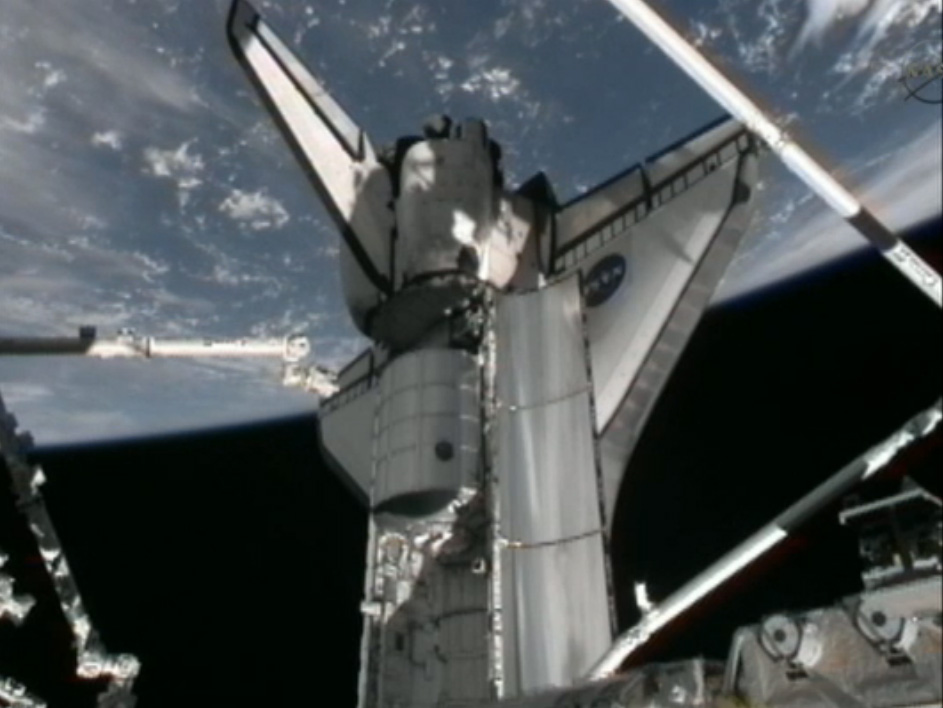At Space Station, Shuttle Astronauts Make Last Big Delivery

This story was updated at 7:42 a.m. EDT.
HOUSTON – The four astronauts aboard space shuttle Atlantis astronauts made the last big delivery of NASA's shuttle era today (July 11) when they attached a bus-size cargo pod filled with a year's worth of supplies to the International Space Station.
In a series of robotic maneuvers, the astronauts installed the giant cargo pod, known as the Multi-Purpose Logistics Module, to the Earth-facing port of the station's Harmony node, where it will stay for the remainder of Atlantis' time at the orbiting outpost. Later today, the astronauts will begin the daunting task of unpacking the module.
The Atlantis crew used the space station's robotic arm to latch onto the cargo pod and transfer it onto the space station's Harmony module. The robotic arm operations began shortly after 5 a.m. EDT (0900 GMT), and the MPLM was successfully installed at 6:46 a.m. EDT (1046 GMT). [9 Weird Things That Flew On NASA's Shuttles]
Members of both the shuttle and station crews will spend the week unpacking the contents of the cargo pod and storing the supplies and hardware on the station before repacking the cargo pod with trash and other items to return to Earth at the end of Atlantis' mission.
Atlantis' heavy haul
Atlantis launched on the final mission of NASA's space shuttle program on July 8, and arrived at the orbiting laboratory yesterday (July 10). Since Atlantis' STS-135 mission is the last-ever shuttle flight, NASA took advantage of the orbiter's enormous capacity by packing the cargo pod to the brim.
Get the Space.com Newsletter
Breaking space news, the latest updates on rocket launches, skywatching events and more!
The shuttle's cargo module, which is named Raffaello, is stuffed with about 9,500 pounds (4,300 kilograms) of supplies and spare parts for the space station. These resources will be used to help keep the station in operation through 2012, following the end of NASA's space shuttle program.
Atlantis' STS-135 mission marks the Raffaello module's fourth and final trip to the space station. Throughout their time at the station, the shuttle astronauts will unpack the MPLM and then re-fill it with 5,600 pounds (2,540 kg) of trash and other unnecessary items that will be brought back to Earth at the end of Atlantis' flight.
The astronauts will round out their day by going over notes and procedures for a spacewalk that will be performed on Tuesday (July 12) by station astronauts Ron Garan and Mike Fossum.
Meanwhile, NASA space junk experts decided today that a piece of orbital debris being tracked by Mission Control will pose no threat to the shuttle or space station when it passes near the linked spacecraft on Tuesday. NASA had been tracking the piece of space debris since yesterday to determine if the linked shuttle and space station would have to fire thrusters to dodge the orbital trash, but a final analysis found that no adjustments would be needed, officials said. [Worst Space Debris Moments of All Time]
Mission's efficient start
Despite being a skeleton crew of only four people, the shuttle astronauts have powered through their objectives, finishing most tasks right on or ahead of schedule, mission managers said.
The remainder of their flight will be busy, with about 30 hours of work required to move cargo out from Atlantis' mid-deck, and nearly 130 hours of work required to unpack everything in the Rafaello cargo pod.
"We're going to be able to keep them very busy," LeRoy Cain, chair of Atlantis' mission management team, said in a news briefing Sunday (July 10).
As the astronauts work hard in orbit, ground teams here in Mission Control at the Johnson Space Center will continue to assess the possibility of extending Atlantis' mission by one extra day.
A bonus day would give the astronauts more time to unpack and store everything brought up on Atlantis, and regular space station operations would benefit with four extra sets of hands, but flight controllers need to be sure that the shuttle has enough onboard resources to make such an extension possible.
Atlantis' current mission is NASA's 135th shuttle flight since the fleet began flying in space in 1981. After this flight, NASA will retire its three shuttles to make way for a new program aimed at deep space exploration.
You can follow SPACE.com Staff Writer Denise Chow on Twitter @denisechow. Visit SPACE.com for complete coverage of Atlantis' final mission STS-135 or follow us @Spacedotcom and on Facebook.
Join our Space Forums to keep talking space on the latest missions, night sky and more! And if you have a news tip, correction or comment, let us know at: community@space.com.

Denise Chow is a former Space.com staff writer who then worked as assistant managing editor at Live Science before moving to NBC News as a science reporter, where she focuses on general science and climate change. She spent two years with Space.com, writing about rocket launches and covering NASA's final three space shuttle missions, before joining the Live Science team in 2013. A Canadian transplant, Denise has a bachelor's degree from the University of Toronto, and a master's degree in journalism from New York University. At NBC News, Denise covers general science and climate change.